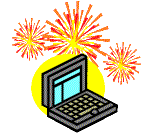Sparks  Fly
Fly
[Home] [PBS
VideoDatabase] [Social Studies] [TSU]
[UVA]
|
Sparks
|
|
What can I do with it?
What's my address? Assigned by your Internet service provider (ISP) the address is composed of three parts and a separation symbol:
csparks@whro.net The Internet works in a standard protocol so all computers can talk to each other. Your e-mail can be received by a PC or a Mac. Virtually any machine can send and receive e-mail. E-mail has two parts: the header and the message. The header contains the information about you, the address of the person you are sending the message, the date, and a subject. The subject line is what you type to briefly describe the message. It is all the receiver will see in their mailbox. The message area is where you expand on your subject, the body of your letter. Most e-mail is very informal. It does not resemble an formal business letter but rather is frequently a short informative note. Netiquette: Dos and Don'ts of E-mailThe Internet is blind--you don't know who you are talking to and it is easy to disguise with pseudonyms so that anonymous letters are possible and really easy. Therefore, it is important to discuss Net etiquette or Netiquette with students. Some issues to discuss:
|
| This page was updated on: 04/10/02 |